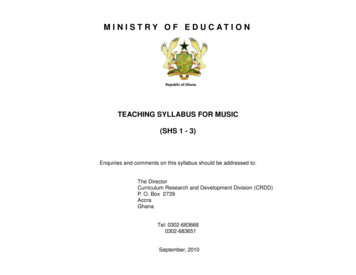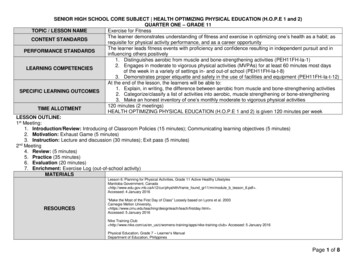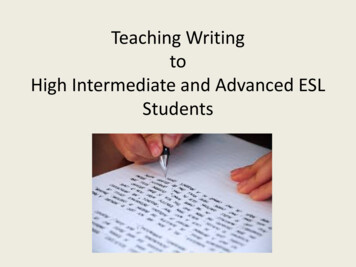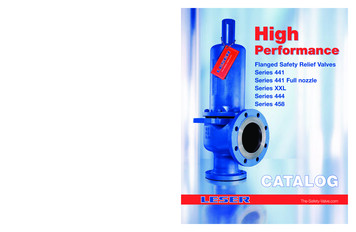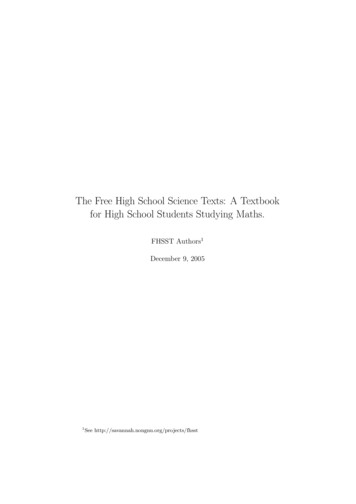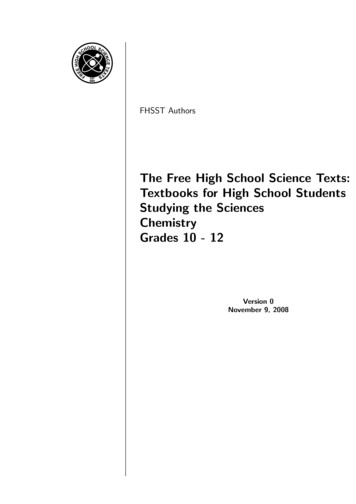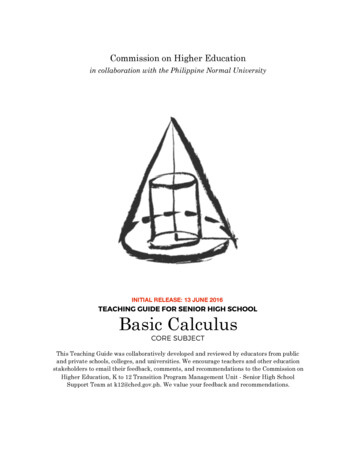
Transcription
Commission on Higher Educationin collaboration with the Philippine Normal UniversityINITIAL RELEASE: 13 JUNE 2016TEACHING GUIDE FOR SENIOR HIGH SCHOOLBasic CalculusCORE SUBJECTThis Teaching Guide was collaboratively developed and reviewed by educators from publicand private schools, colleges, and universities. We encourage teachers and other educationstakeholders to email their feedback, comments, and recommendations to the Commission onHigher Education, K to 12 Transition Program Management Unit - Senior High SchoolSupport Team at k12@ched.gov.ph. We value your feedback and recommendations.
Published by the Commission on Higher Education, 2016Chairperson: Patricia B. Licuanan, Ph.D.Commission on Higher EducationK to 12 Transition Program Management UnitOffice Address: 4th Floor, Commission on Higher Education,C.P. Garcia Ave., Diliman, Quezon CityTelefax: (02) 441-1143 / E-mail Address: k12@ched.gov.phDEVELOPMENT TEAMTeam Leader: Jose Maria P. Balmaceda, Ph.D.Writers:Carlene Perpetua P. Arceo, Ph.D.Richard S. Lemence, Ph.D.Oreste M. Ortega, Jr., M.Sc.Louie John D. Vallejo, Ph.D.Technical Editors:Jose Ernie C. Lope, Ph.D.Marian P. Roque, Ph.D.Copy Reader: Roderick B. LiriosCover Artists: Paolo Kurtis N. Tan, Renan U. OrtizCONSULTANTSTHIS PROJECT WAS DEVELOPED WITH THE PHILIPPINE NORMAL UNIVERSITY.University President: Ester B. Ogena, Ph.D.VP for Academics: Ma. Antoinette C. Montealegre, Ph.D.VP for University Relations & Advancement: Rosemarievic V. Diaz, Ph.D.Ma. Cynthia Rose B. Bautista, Ph.D., CHEDBienvenido F. Nebres, S.J., Ph.D., Ateneo de Manila UniversityCarmela C. Oracion, Ph.D., Ateneo de Manila UniversityMinella C. Alarcon, Ph.D., CHEDGareth Price, Sheffield Hallam UniversityStuart Bevins, Ph.D., Sheffield Hallam UniversitySENIOR HIGH SCHOOL SUPPORT TEAMCHED K TO 12 TRANSITION PROGRAM MANAGEMENT UNITProgram Director: Karol Mark R. YeeLead for Senior High School Support: Gerson M. AbesamisLead for Policy Advocacy and Communications: Averill M. PizarroCourse Development Officers:Danie Son D. Gonzalvo, John Carlo P. FernandoTeacher Training Officers:Ma. Theresa C. Carlos, Mylene E. DonesMonitoring and Evaluation Officer: Robert Adrian N. DaulatAdministrative Officers: Ma. Leana Paula B. Bato,Kevin Ross D. Nera, Allison A. Danao, Ayhen Loisse B. DalenaThis Teaching Guide by theCommission on Higher Educationis licensed under a CreativeCommons AttributionNonCommercial-ShareAlike4.0 International License. Thismeans you are free to:Share — copy and redistributethe material in any medium orformatAdapt — remix, transform, andbuild upon the material.The licensor, CHED, cannotrevoke these freedoms as long asyou follow the license terms.However, under the followingterms:Attribution — You must giveappropriate credit, provide a linkto the license, and indicate ifchanges were made. You may doso in any reasonable manner, butnot in any way that suggests thelicensor endorses you or your use.NonCommercial — You maynot use the material forcommercial purposes.ShareAlike — If you remix,transform, or build upon thematerial, you must distributeyour contributions under thesame license as the original.Printed in the Philippines by EC-TECCommercial, No. 32 St. LouisCompound 7, Baesa, Quezon City,ectec com@yahoo.com
ContentsIntroduction . . . . . . . . . . . . . . . . . . . . . . . . . . . . . . . . . . . . . . . . . . . . . . . . . . . . . . . . . . . . . . . . . . . .ivDepEd Basic Calculus Curriculum Guide . . . . . . . . . . . . . . . . . . . . . . . . . . . . . . . . . . . . . . . . . . . .vii1 Limits and Continuity . . . . . . . . . . . . . . . . . . . . . . . . . . . . . . . . . . . . . . . . . . . . . . . . . . . . . . . .1Lesson 1: The Limit of a Function: Theorems and Examples . . . . . . . . . . . . . . . . . . . . . . . 2Topic 1.1: The Limit of a Function . . . . . . . . . . . . . . . . . . . . . . . . . . . . . . . . . . . . . .3Topic 1.2: The Limit of a Function at c versus the Value of a Function at c . . . . .17Topic 1.3: Illustration of Limit Theorems . . . . . . . . . . . . . . . . . . . . . . . . . . . . . . . . . 22Topic 1.4: Limits of Polynomial, Rational, and Radical Functions . . . . . . . . . . . . . 28Lesson 2: Limits of Some Transcendental Functions and Some Indeterminate Forms . .38Topic 2.1: Limits of Exponential, Logarithmic, and Trigonometric Functions . . . . 39Topic 2.2: Some Special Limits . . . . . . . . . . . . . . . . . . . . . . . . . . . . . . . . . . . . . . . . .46Lesson 3: Continuity of Functions . . . . . . . . . . . . . . . . . . . . . . . . . . . . . . . . . . . . . . . . . . . .52Topic 3.1: Continuity at a Point . . . . . . . . . . . . . . . . . . . . . . . . . . . . . . . . . . . . . . . .53Topic 3.2: Continuity on an Interval . . . . . . . . . . . . . . . . . . . . . . . . . . . . . . . . . . . . . 58Lesson 4: More on Continuity . . . . . . . . . . . . . . . . . . . . . . . . . . . . . . . . . . . . . . . . . . . . . . . . 64Topic 4.1: Different Types of Discontinuities . . . . . . . . . . . . . . . . . . . . . . . . . . . . . . 65Topic 4.2: The Intermediate Value and the Extreme Value Theorems . . . . . . . . .75Topic 4.3: Problems Involving Continuity . . . . . . . . . . . . . . . . . . . . . . . . . . . . . . . .852 Derivatives . . . . . . . . . . . . . . . . . . . . . . . . . . . . . . . . . . . . . . . . . . . . . . . . . . . . . . . . . . . . . . . . . .89Lesson 5: The Derivative as the Slope of the Tangent Line . . . . . . . . . . . . . . . . . . . . . . . .90Topic 5.1: The Tangent Line to the Graph of a Function at a Point . . . . . . . . . . . . 91Topic 5.2: The Equation of the Tangent Line . . . . . . . . . . . . . . . . . . . . . . . . . . . . . . 100Topic 5.3: The Definition of the Derivative . . . . . . . . . . . . . . . . . . . . . . . . . . . . . . .107Lesson 6: Rules of Differentiation . . . . . . . . . . . . . . . . . . . . . . . . . . . . . . . . . . . . . . . . . . . . . 119Topic 6.1: Differentiability Implies Continuity . . . . . . . . . . . . . . . . . . . . . . . . . . . .i120
Topic 6.2: The Differentiation Rules and Examples Involving Algebraic,Exponential, and Trigonometric Functions . . . . . . . . . . . . . . . . . . . . . . . . . . . . . . .126Lesson 7: Optimization . . . . . . . . . . . . . . . . . . . . . . . . . . . . . . . . . . . . . . . . . . . . . . . . . . . . .141Topic 7.1: Optimization using Calculus . . . . . . . . . . . . . . . . . . . . . . . . . . . . . . . . . .142Lesson 8: Higher-Order Derivatives and the Chain Rule . . . . . . . . . . . . . . . . . . . . . . . . . .156Topic 8.1: Higher-Order Derivatives of Functions . . . . . . . . . . . . . . . . . . . . . . . . . . 157Topic 8.2: The Chain Rule . . . . . . . . . . . . . . . . . . . . . . . . . . . . . . . . . . . . . . . . . . . . . 162Lesson 9: Implicit Differentiation . . . . . . . . . . . . . . . . . . . . . . . . . . . . . . . . . . . . . . . . . . . . . 168Topic 9.1: What is Implicit Differentiation? . . . . . . . . . . . . . . . . . . . . . . . . . . . . . . . 169Lesson 10: Related Rates . . . . . . . . . . . . . . . . . . . . . . . . . . . . . . . . . . . . . . . . . . . . . . . . . . . . 180Topic 10.1: Solutions to Problems Involving Related Rates . . . . . . . . . . . . . . . . . .1813 Integration . . . . . . . . . . . . . . . . . . . . . . . . . . . . . . . . . . . . . . . . . . . . . . . . . . . . . . . . . . . . . . . . . .191Lesson 11: Integration . . . . . . . . . . . . . . . . . . . . . . . . . . . . . . . . . . . . . . . . . . . . . . . . . . . . . . 192Topic 11.1: Illustration of an Antiderivative of a Function . . . . . . . . . . . . . . . . . . . 193Topic 11.2: Antiderivatives of Algebraic Functions . . . . . . . . . . . . . . . . . . . . . . . . . 196Topic 11.3: Antiderivatives of Functions Yielding Exponential Functions andLogarithmic Functions . . . . . . . . . . . . . . . . . . . . . . . . . . . . . . . . . . . . . . . . . . . . . . . . 199Topic 11.4: Antiderivatives of Trigonometric Functions . . . . . . . . . . . . . . . . . . . . .202Lesson 12: Techniques of Antidifferentiation . . . . . . . . . . . . . . . . . . . . . . . . . . . . . . . . . . .204Topic 12.1: Antidifferentiation by Substitution and by Table of Integrals . . . . . . . 205Lesson 13: Application of Antidifferentiation to Differential Equations . . . . . . . . . . . . . .217Topic 13.1: Separable Differential Equations . . . . . . . . . . . . . . . . . . . . . . . . . . . . .218Lesson 14: Application of Differential Equations in Life Sciences . . . . . . . . . . . . . . . . . . .224Topic 14.1: Situational Problems Involving Growth and Decay Problems . . . . . . . 225Lesson 15: Riemann Sums and the Definite Integral . . . . . . . . . . . . . . . . . . . . . . . . . . . . .Topic 15.1: Approximation of Area using Riemann Sums . . . . . . . . . . . . . . . . . . .237238Topic 15.2: The Formal Definition of the Definite Integral . . . . . . . . . . . . . . . . . . . 253Lesson 16: The Fundamental Theorem of Calculus . . . . . . . . . . . . . . . . . . . . . . . . . . . . . .268Topic 16.1: Illustration of the Fundamental Theorem of Calculus . . . . . . . . . . . . . 269Topic 16.2: Computation of Definite Integrals using the Fundamental Theoremof Calculus . . . . . . . . . . . . . . . . . . . . . . . . . . . . . . . . . . . . . . . . . . . . . . . . . . . . . . . . .ii273
Lesson 17: Integration Technique: The Substitution Rule for Definite Integrals . . . . . . .280Topic 17.1: Illustration of the Substitution Rule for Definite Integrals . . . . . . . . . 281Lesson 18: Application of Definite Integrals in the Computation of Plane Areas . . . . . . .292Topic 18.1: Areas of Plane Regions Using Definite Integrals . . . . . . . . . . . . . . . . .293Topic 18.2: Application of Definite Integrals: Word Problems . . . . . . . . . . . . . . . .304Biographical Notes . . . . . . . . . . . . . . . . . . . . . . . . . . . . . . . . . . . . . . . . . . . . . . . . . . . . . . . . . . . .309iii
IntroductionAs the Commission supports DepEd’s implementation of Senior High School (SHS), it upholds the visionand mission of the K to 12 program, stated in Section 2 of Republic Act 10533, or the Enhanced BasicEducation Act of 2013, that “every graduate of basic education be an empowered individual, through aprogram rooted on.the competence to engage in work and be productive, the ability to coexist in fruitfulharmony with local and global communities, the capability to engage in creative and critical thinking,and the capacity and willingness to transform others and oneself.”To accomplish this, the Commission partnered with the Philippine Normal University (PNU), theNational Center for Teacher Education, to develop Teaching Guides for Courses of SHS. Together withPNU, this Teaching Guide was studied and reviewed by education and pedagogy experts, and wasenhanced with appropriate methodologies and strategies.Furthermore, the Commission believes that teachers are the most important partners in attaining thisgoal. Incorporated in this Teaching Guide is a framework that will guide them in creating lessons andassessment tools, support them in facilitating activities and questions, and assist them towards deepercontent areas and competencies. Thus, the introduction of the SHS for SHS Framework.The SHS for SHS FrameworkThe SHS for SHS Framework, which stands for “Saysay-Husay-Sarili for Senior High School,” is at thecore of this book. The lessons, which combine high-quality content with flexible elements toaccommodate diversity of teachers and environments, promote these three fundamental concepts:SAYSAY: MEANINGHUSAY: MASTERYSARILI: OWNERSHIPWhy is this important?How will I deeply understand this?What can I do with this?Through this Teaching Guide,teachers will be able tofacilitate an understanding ofthe value of the lessons, foreach learner to fully engage inthe content on both thecognitive and affective levels.Given that developing masterygoes beyond memorization,teachers should also aim for deepunderstanding of the subjectmatter where they lead learnersto analyze and synthesizeknowledge.When teachers empowerlearners to take ownership oftheir learning, they developindependence and selfdirection, learning about boththe subject matter andthemselves.iv
The Parts of the Teaching GuidePedagogical NotesThis Teaching Guide is mapped and aligned to theDepEd SHS Curriculum, designed to be highlyusable for teachers. It contains classroom activitiesand pedagogical notes, and integrated withinnovative pedagogies. All of these elements arepresented in the following parts:The teacher should strive to keep a good balancebetween conceptual understanding and facility inskills and techniques. Teachers are advised to beconscious of the content and performancestandards and of the suggested time frame foreach lesson, but flexibility in the management ofthe lessons is possible. Interruptions in the classschedule, or students’ poor reception or difficultywith a particular lesson, may require a teacher toextend a particular presentation or discussion.1. INTRODUCTION Highlight key concepts and identify theessential questions Show the big picture Connect and/or review prerequisiteknowledge Clearly communicate learningcompetencies and objectives Motivate through applications andconnections to real-lifeComputations in some topics may be facilitated bythe use of calculators. This is encour- aged;however, it is important that the studentunderstands the concepts and processes involvedin the calculation. Exams for the Basic Calculuscourse may be designed so that calculators are notnecessary.Because senior high school is a transition periodfor students, the latter must also be prepared forcollege-level academic rigor. Some topics incalculus require much more rigor and precisionthan topics encountered in previous mathematicscourses, and treatment of the material may bedifferent from teaching more elementary courses.The teacher is urged to be patient and careful inpresenting and developing the topics. To avoid toomuch technical discussion, some ideas can beintroduced intuitively and informally, withoutsacrificing rigor and correctness.2. INSTRUCTION/DELIVERY Give a demonstration/lecture/simulation/hands-on activity Show step-by-step solutions to sampleproblems Use multimedia and other creative tools Give applications of the theory Connect to a real-life problem if applicable3. PRACTICE Discuss worked-out examples Provide easy-medium-hard questions Give time for hands-on unguided classroomwork and discovery Use formative assessment to give feedbackThe teacher is encouraged to study the guide verywell, work through the examples, and solveexercises, well in advance of the lesson. Thedevelopment of calculus is one of humankind’sgreatest achievements. With patience, motivationand discipline, teaching and learning calculuseffectively can be realized by anyone. The teachingguide aims to be a valuable resource in thisobjective.4. ENRICHMENT Provide additional examples andapplications Introduce extensions or generalisations ofconcepts Engage in reflection questions Encourage analysis through higher orderthinking prompts5. EVALUATION Supply a diverse question bank for writtenwork and exercises Provide alternative formats for studentwork: written homework, journal, portfolio,group/individual projects, student-directedresearch projectv
On DepEd Functional Skills and CHED’s College Readiness StandardsAs Higher Education Institutions (HEIs) welcome the graduates of the Senior High School program, it isof paramount importance to align Functional Skills set by DepEd with the College Readiness Standardsstated by CHED.The DepEd articulated a set of 21st century skills that should be embedded in the SHS curriculum acrossvarious subjects and tracks. These skills are desired outcomes that K to 12 graduates should possess inorder to proceed to either higher education, employment, entrepreneurship, or middle-level skillsdevelopment.On the other hand, the Commission declared the College Readiness Standards that consist of thecombination of knowledge, skills, and reflective thinking necessary to participate and succeed - withoutremediation - in entry-level undergraduate courses in college.The alignment of both standards, shown below, is also presented in this Teaching Guide - preparesSenior High School graduates to the revised college curriculum which will initially be implemented byAY 2018-2019.College Readiness Standards Foundational SkillsDepEd Functional SkillsProduce all forms of texts (written, oral, visual, digital) based on:1. Solid grounding on Philippine experience and culture;2. An understanding of the self, community, and nation;3. Application of critical and creative thinking and doing processes;4. Competency in formulating ideas/arguments logically, scientifically,and creatively; and5. Clear appreciation of one’s responsibility as a citizen of a multiculturalPhilippines and a diverse world;Visual and information literaciesMedia literacyCritical thinking and problem solving skillsCreativityInitiative and self-directionSystematically apply knowledge, understanding, theory, and skillsfor the development of the self, local, and global communities usingprior learning, inquiry, and experimentationGlobal awarenessScientific and economic literacyCuriosityCritical thinking and problem solving skillsRisk takingFlexibility and adaptabilityInitiative and self-directionWork comfortably with relevant technologies and developadaptations and innovations for significant use in local and globalcommunities;Global awarenessMedia literacyTechnological literacyCreativityFlexibility and adaptabilityProductivity and accountabilityCommunicate with local and global communities with proficiency,orally, in writing, and through new technologies of communication;Global awarenessMulticultural literacyCollaboration and interpersonal skillsSocial and cross-cultural skillsLeadership and responsibilityInteract meaningfully in a social setting and contribute to thefulfilment of individual and shared goals, respecting thefundamental humanity of all persons and the diversity of groupsand communitiesMedia literacyMulticultural literacyGlobal awarenessCollaboration and interpersonal skillsSocial and cross-cultural skillsLeadership and responsibilityEthical, moral, and spiritual valuesvi
K to 12 BASIC EDUCATION CURRICULUMSENIOR HIGH SCHOOL – SCIENCE, TECHNOLOGY, ENGINEERING AND MATHEMATICS (STEM) SPECIALIZED culusSubject Description: At the end of the course, the students must know how to determine the limit of a function, differentiate, and integrate algebraic,exponential, logarithmic, and trigonometric functions in one variable, and to formulate and solve problems involving continuity, extreme values, related rates,population models, and areas of plane regions.CONTENTLimits andContinuityCONTENTSTANDARDSThe learnersdemonstrate anunderstanding of.the basic conceptsof limit andcontinuity of afunctionPERFORMANCELEARNING COMPETENCIESSTANDARDSThe learners shall be able The learners to.1.illustrate the limit of a function using a table offormulate and solvevalues and the graph of the functionaccurately real-life2.distinguish between limx cf(x)!and f(c)problems involving3.illustrate the limit lawscontinuity of functions4.apply the limit laws in evaluating the limit ofalgebraic functions (polynomial, rational, andradical)5.compute the limits of exponential, logarithmic,andtrigonometric functions using tables of values andgraphs of the functions6.evaluate limits involving the expressions (sint)/t ,(1-cost)/t and (et - 1)/t using tables of values7.illustrate continuity of a function at a number8. determine whether a function is continuous at anumber or not9.illustrate continuity of a function on an interval10. determine whether a function is continuous on aninterval or not.CODETOPICNUMBERSTEM BC11LC-IIIa-11.1STEM BC11LC-IIIa-2STEM BC11LC-IIIa-31.21.3STEM BC11LC-IIIa-41.4STEM BC11LC-IIIb-12.1STEM BC11LC-IIIb-22.2STEM BC11LC-IIIc-1STEM BC11LC-IIIc-2STEM BC11LC-IIIc-3STEM BC11LC-IIIc-43.13.2
K to 12 BASIC EDUCATION CURRICULUM!SENIOR HIGH SCHOOL – SCIENCE, TECHNOLOGY, ENGINEERING AND MATHEMATICS (STEM) SPECIALIZED LEARNING COMPETENCIES11. illustrate different types of discontinuity(hole/removable, jump/essential, asymptotic/infinite)12. illustrate the Intermediate Value and ExtremeValue Theorems13. solves problems involving continuity of a functionDerivativesbasic concepts ofderivatives1. formulate and solveaccurately situationalproblems involvingextreme valuesCODETOPICNUMBERSTEM BC11LC-IIId-14.1STEM BC11LC-IIId-24.2STEM BC11LC-IIId-34.31. illustrate the tangent line to the graph of a functionSTEM BC11D-IIIe-1at a given point2. applies the definition of the derivative of a functionSTEM BC11D-IIIe-2at a given number3. relate the derivative of a function to the slope ofSTEM BC11D-IIIe-3the tangent line4. determine the relationship between differentiabilitySTEM BC11D -IIIf-1and continuity of a function5.derive the differentiation rulesSTEM BC11D-IIIf-26. apply the differentiation rules in computing theSTEM BC11D-IIIf-3derivative of an algebraic, exponential, andtrigonometric functions7.solve optimization problemsSTEM BC11D-IIIg-12.formulate and solve 8.compute higher-order derivatives of functionsSTEM BC11D-IIIh-1accurately situational9.illustrate the Chain Rule of differentiationSTEM BC11D-IIIh-2problems involving10. solve problems using the Chain RuleSTEM BC11D-IIIh-i-1related rates11. illustrate implicit differentiationSTEM BC11D-IIIi-212. solve problems (including logarithmic, and inverseSTEM BC11D-IIIi-j-1trigonometric functions) using implicitdifferentiation13. solve situational problems involving related ratesSTEM BC11D-IIIj-25.15.35.26.16.27.18.18.29.110.1
K to 12 BASIC EDUCATION CURRICULUMSENIOR HIGH SCHOOL – SCIENCE, TECHNOLOGY, ENGINEERING AND MATHEMATICS (STEM) SPECIALIZED atives andRiemann integralPERFORMANCESTANDARDS1.formulate and solveaccurately situationalproblems involvingpopulation models2. formulate and solveaccurately real-lifeproblems involving areasof plane regionsLEARNING COMPETENCIESCODE1.illustrate an antiderivative of a functionSTEM BC11I-IVa-12.compute the general antiderivative ofSTEM BC11I-IVa-b-1polynomial, radical, exponential, and trigonometricfunctions3.compute the antiderivative of a function usingsubstitution rule and table of integrals (includingthoseSTEM BC11I-IVb-c-1whose antiderivatives involve logarithmic and inversetrigonometric functions)4.solve separable differential equations usingSTEM BC11I-IVd-1antidifferentiation5.solve situational problems involving exponentialgrowth and decay, bounded growth, and logistic growth STEM BC11I-IVe-f-16.approximate the area of a region under a curveusing Riemann sums: (a) left, (b) right, and (c)midpoint7.define the definite integral as the limit of theRiemann sums8.illustrate the Fundamental Theorem of Calculus9. compute the definite integral of a function usingthe Fundamental Theorem of Calculus10. illustrates the substitution rule11. compute the definite integral of a function usingthe substitution rule12. compute the area of a plane region using thedefinite integral13. solve problems involving areas of plane regionsTOPICNUMBER11.111.2J11.412.113.114.1STEM BC11I-IVg-115.1STEM BC11I-IVg-215.2STEM BC11I-IVh-116.1STEM BC11I-IVh-216.2STEM BC11I-IVi-1STEM BC11I-IVi-217.1STEM BC11I-IVi-j-118.1STEM BC11I-IVj-218.2
Chapter 1Limits and Continuity
LESSON 1: The Limit of a Function: Theorems and ExamplesTIME FRAME: 4 hoursLEARNING OUTCOMES: At the end of the lesson, the learner shall be able to:1. Illustrate the limit of a function using a table of values and the graph of the function;2. Distinguish between lim f (x) and f (c);x!c3. Illustrate the limit theorems; and4. Apply the limit theorems in evaluating the limit of algebraic functions (polynomial, rational, and radical).LESSON OUTLINE:1. Evaluation of limits using a table of values2. Illustrating the limit of a function using the graph of the function3. Distinguishing between lim f (x) and f (c) using a table of valuesx!c4. Distinguishing between lim f (x) and f (c) using the graph of y f (x)x!c5. Enumeration of the eight basic limit theorems6. Application of the eight basic limit theorems on simple examples7. Limits of polynomial functions8. Limits of rational functions9. Limits of radical functions10. Intuitive notions of infinite limits2
TOPIC 1.1: The Limit of a FunctionDEVELOPMENT OF THE LESSON(A) ACTIVITYIn order to find out what the students’ idea of a limit is, ask them to bring cutouts ofnews items, articles, or drawings which for them illustrate the idea of a limit. These maybe posted on a wall so that they may see each other’s homework, and then have each oneexplain briefly why they think their particular cutout represents a limit.(B) INTRODUCTIONLimits are the backbone of calculus, and calculus is called the Mathematics of Change.The study of limits is necessary in studying change in great detail. The evaluation of aparticular limit is what underlies the formulation of the derivative and the integral of afunction.For starters, imagine that you are going to watch a basketball game. When you chooseseats, you would want to be as close to the action as possible. You would want to be asclose to the players as possible and have the best view of the game, as if you were in thebasketball court yourself. Take note that you cannot actually be in the court and join theplayers, but you will be close enough to describe clearly what is happening in the game.This is how it is with limits of functions. We will consider functions of a single variable andstudy the behavior of the function as its variable approaches a particular value (a constant).The variable can only take values very, very close to the constant, but it cannot equal theconstant itself. However, the limit will be able to describe clearly what is happening to thefunction near that constant.(C) LESSON PROPERConsider a function f of a single variable x. Consider a constant c which the variable xwill approach (c may or may not be in the domain of f ). The limit, to be denoted by L, isthe unique real value that f (x) will approach as x approaches c. In symbols, we write thisprocess aslim f (x) L.x!cThis is read, ‘ ‘The limit of f (x) as x approaches c is L.”3
LOOKING AT A TABLE OF VALUESTo illustrate, let us considerlim (1 3x).x!2Here, f (x) 1 3x and the constant c, which x will approach, is 2. To evaluate the givenlimit, we will make use of a table to help us keep track of the effect that the approach of xtoward 2 will have on f (x). Of course, on the number line, x may approach 2 in two ways:through values on its left and through values on its right. We first consider approaching 2from its left or through values less than 2. Remember that the values to be chosen shouldbe close to 2.xf 56.9916.99976.9999997Now we consider approaching 2 from its right or through values greater than but close to 2.xf 097.0277.00157.0000003Observe that as the values of x get closer and closer to 2, the values of f (x) get closer andcloser to 7. This behavior can be shown no matter what set of values, or what direction, istaken in approaching 2. In symbols,lim (1 3x) 7.x!24
EXAMPLE 1: Investigatelim (x2 1)x! 1by constructing tables of values. Here, c We start again by approaching1 from the left.xf (x)1.51.21.011.0001Now approach1 and f (x) x2 1.3.252.442.02012.000200011 from the right.xf (x)0.50.80.990.9999The tables show that as x approaches1.251.641.98011.999800011, f (x) approaches 2. In symbols,lim (x2 1) 2.x! 1EXAMPLE 2: Investigate lim x through a table of values.x!0Approaching 0 from the left and from the right, we get the following tables:x0.30.010.000090.00000001 x ence,lim x 0.x!05 x 0.30.010.000090.00000001
EXAMPLE 3: Investigatelimx2x!15x 4x 1x2 5x 4by constructing tables of values. Here, c 1 and f (x) .x 1Take note that 1 is not in the domain of f , but this is not a problem. In evaluating a limit,remember that we only need to go very close to 1; we will not go to 1 itself.We now approach 1 from the left.xf (x)1.51.171.0031.00012.52.832.9972.9999Approach 1 from the right.xf (x)0.50.880.9960.99993.53.123.0043.0001The tables show that as x approaches 1, f (x) approacheslimx2x!15x 4 x 13. In symbols,3.EXAMPLE 4: Investigate through a table of valueslim f (x)x!4iff (x) 8 x 1:(x4)2 3if x 4if x4.This looks a bit different, but the logic and procedure are exactly the same. We stillapproach the constant 4 from the left and from the right, but note that we should evaluatethe appropriate corresponding functional expression. In this case, when x approaches 4from the left, the values taken should be substituted in f (x) x 1. Indeed, this is thepart of the function which accepts values less than 4. So,6
xf (x)3.73.853.9953.999994.74.854.9954.99999On the other hand, when x approaches 4 from the right, the values taken should be substituted in f (x) (x 4)2 3. So,xf bserve that the values that f (x) approaches are not equal, namely, f (x) approaches 5from the left while it approaches 3 from the right. In such a case, we say that the limit ofthe given function does not exist (DNE). In symbols,lim f (x) DNE.x!4Remark 1:We need to emphasize an important fact. We do not say that lim f (x)x!4“equals DNE”, nor do we write “ lim f (x) DNE”, because “DNE” is not
Jun 13, 2016 · in the calculation. Exams for the Basic Calculus course may be designed so that calculators are not necessary. Because senior high school is a transition period for students, the latter must also be prepared for college-level academic rigor. Some topics in calculus require much more ri
